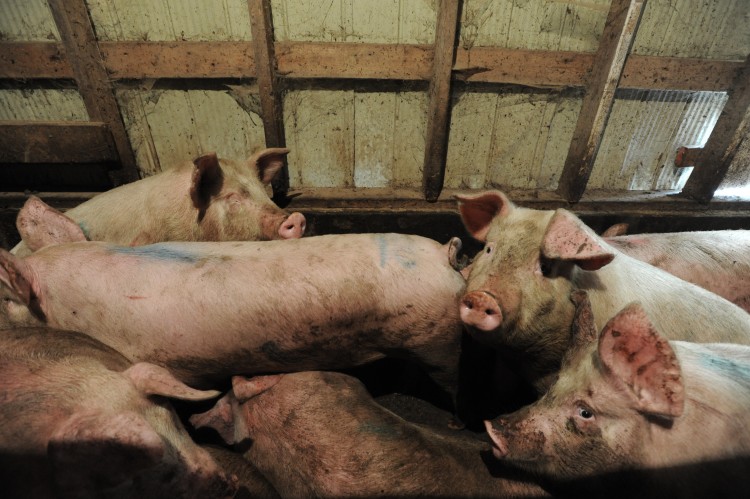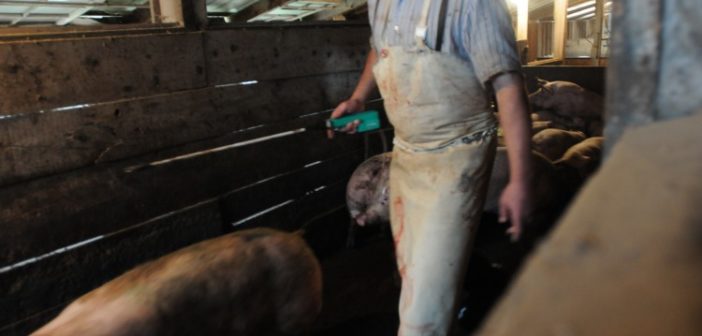Kristina Mering is an MA student of sociology at Estonia’s Tallinn University, and has conducted interviews with slaughterhouse workers about their attitudes towards animals and their job. She did this at the largest slaughterhouse in Estonia. I interviewed her after her talk at the CARE conference (Conference on Animal Rights in Europe) in Warsaw.
Vegan Strategist: What prompted you to do this research?
Kristina Mering: This research project was a part of my undergraduate studies in sociology. I chose the topic of slaughterhouse workers because it seemed like interesting material for research. I also wanted to understand how these people cope with the violent nature of their work. To me it seemed like a good way to understand the human-animal relationship on a broader level.
Can you describe this slaughterhouse? Is it representative of the industry?
It’s the biggest and the most modern slaughterhouse in Estonia. They kill both pigs and cows. There are 21 people involved in dismantling the body of a pig, 37 for a cow. The line starts with the stabbing and ends with marking the meat for nutritional content. The pigs are put in gas chambers before they are killed by a stab in the neck. The pigs used to receive electric shocks to make them unconscious before the stab, but this sometimes made the bigger pigs even more anxious rather than unconscious, so they changed it. The gas chambers are also torture but at least the pigs won’t be stabbed while conscious. It’s the lesser of two evils
What are the qualifications people need to apply for a job at this slaughterhouse?
There are no real job requirements. Basically the hiring procedure was as simple as this: the applicants are shown a video of the slaughter process. Those that don’t vomit, get accepted. They learn everything while doing the job.
What are the working circumstances like?
There’s a really high work pace. About three pigs are killed per minute. The workers are subject to rapid repetitive movements, incurring blisters and stiffness, having to work in heat and cold with really sharp knives which can cause accidents. All agreed that they were underpaid for the work that they do.

Pigs crowd together inside slaughterhouse chute at a Southern Ontario slaughterhouse. Image credit Jo-Anne McArthur / We Animals.
What do the slaughterhouse workers think about their job?
None of the interviewees saw it as their calling in life and the way they ended up working in a slaughterhouse was mostly coincidental. Basically, they’re working there because other options are rather unavailable. The turnover is extremely high.
How do they deal with the “unpleasantness” of the work?
In order for them to be able to do their work, they need to block out all emotions. Since they understand that they are taking the life of an animal, they need a strong blocking mechanism to keep thoughts like this out. They build a routine that numbs the emotions and lets them do their work without thinking about the killing. When I asked one person about the stabbing, they put it like this: “If we would think about it, it would be the wrong place to work.” They wear earphones and listen to music or the radio. The belief that there have to be slaughterers in the world, that someone has to do the killing, also helps them cope. There seemed to be an urge to justify the slaughterhouse as an institution, and their role in it.
They couldn’t imagine a world without slaughterhouses?
They couldn’t envisage a vegetarian world. When I asked them about a world without slaughterhouses, it rather made them confused about who would kill the animals raised in farms then.
What is the most surprising thing you learned?
That none of these workers was able to kill baby calves. Sometimes a barn in the region burns down and the owners look for a way to get rid of the calves, which then go to the slaughterhouse. The usual blocking mechanisms don’t seem to work with these young animals. “Calves are something different,” one of the workers told me, “I’m unable to make my heart cold to them”. The tears of baby calves affect the workers a lot more than the tears of adult cows, which they see on a daily basis. So the surprising thing was, that when fifteen or so calves were sent to the slaughterhouse during an emergency, the workers couldn’t kill them and they were actually sent back.
It seems to me that killing so many animals daily is a pretty inhumane thing to ask of people. On the other hand, it might be even more problematic if no humans were involved and everything would be done by machines…
Yes, if no humans were involved, this would obviously create even more distance between the act of killing and meat production and consumption. There is indeed a very strong tendency to automatize the whole process, and I would expect that somewhere in the future there will be just a few people supervising the whole thing. It probably wouldn’t be easy, however, to automatize the whole process. In this particular slaughterhouse, for instance, ten people are involved in just the skinning of the cow.
How was it for you to do this research?
I completely switched off my emotions, I guess in a similar way to what the workers do. While observing the kill line and seeing animals being bled to death in front of me, I tried to be as rational as possible about it, and to get as much info about the situation as I could. I saw it as an opportunity. I asked questions while the pigs were being killed. It was only when I was on the bus back to my home town and I could breathe calmly, that I noticed how my legs had started shaking. It was the first moment that I could be myself again and I understood how it had affected me. I still have the boots covered with blood stains from the slaughterhouse.
Did you find it possible, or easy, to empathize with the slaughterhouse workers?
I wanted to gather info to understand what it’s like for them to do this kind of job. It kind of persuaded me that it is unimaginably difficult and that their hands are often tied. What is also important is that they didn’t make this choice voluntarily. I don’t empathize with what they are saying about killing animals, obviously. But I don’t need to agree with their stance on animals in order to understand that what they are going through is also very hard.
What would you reply if someone said that we shouldn’t pity those people because what the animals are going through is incomparably worse?
The fact that what animals go through is worse, does not mean we shouldn’t have compassion for the workers themselves This isn’t about some suffering-competition, but about seeing the problems of the system as a whole. I believe the horrible working conditions at slaughterhouses can in some cases be a helpful argument for people who don’t get the “animal message”.
What do you hope to achieve with this research?
My aim was to peek inside the slaughterhouse and to show that the workers there shouldn’t be called “evil” or “bad people,” as I sometimes hear from some animal advocates. The core problem is the animal-industrial complex, the system of exploiting animals, which also has negative effects on the workers in the system who are supposed to be the people keeping the system alive and going.
Further resources on this topic:
- Timothy Patchirat, Every Twelve Seconds
- Gail Eisnitz, Slaughterhouse
- Jennifer Dillard, A Slaughterhouse Nightmare
Featured image: a slaughterhouse worker drives pigs down the chute towards slaughter. Image credit Jo-Anne McArthur / We Animals.






